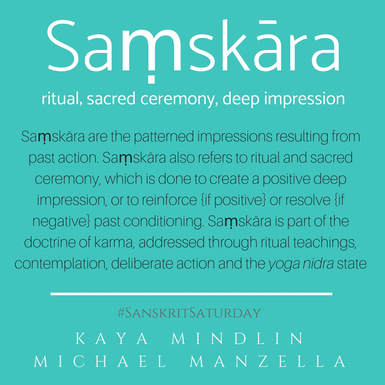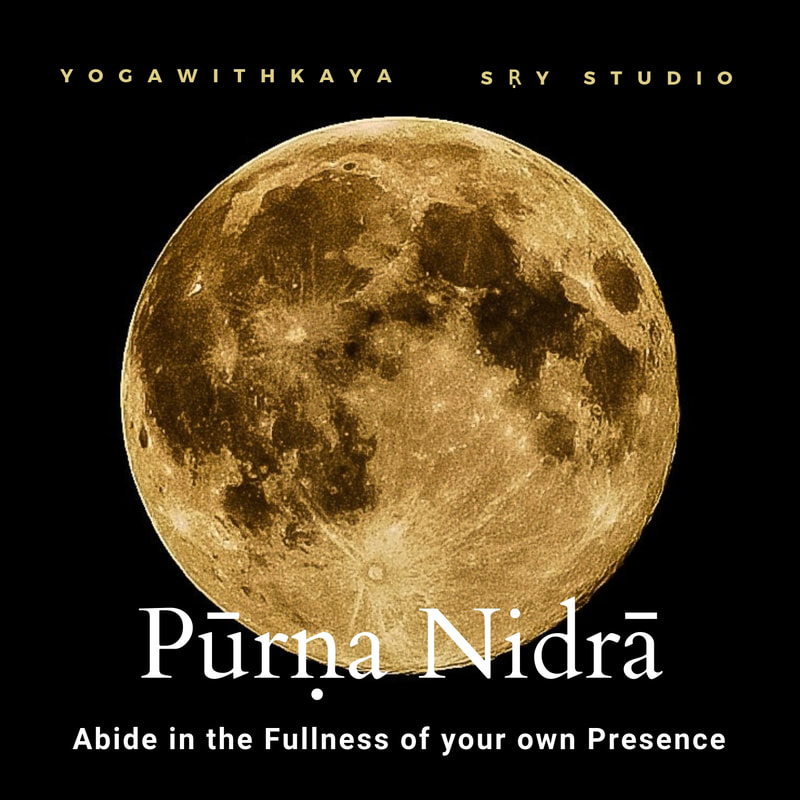Shavasana & Yoga Nidra
Exploring the healing potential of Shavasana and the Yoga Nidra experience.
This Week's Materials
Build your storehouse of sleep knowledge.
Supported Shavasana Handout ~ Click to Download & Print!
| supported_śavāsana_pose_handout_sry_kaya.pdf | |
| File Size: | 185 kb |
| File Type: | |
|
Shavasana Pose Pointers!
|
Read about Shavasana with this article from Kaya
|
Guided awarenessThe Pūrna Nidrā deep relaxation is designed to alleviate stress and anxiety by cultivating a deep sense of inner security and the knowledge that "I am whole and complete as I am". Recommended for those suffering from anxiety, overdoing, inner pressure and stress. Also recommended for yogis who are interested in cultivating a direct experience of the traditional teaching of the Self as Purna.
This track begins with Shavasana recommendations for the body and an explanation of the purpose of the practice. |
Listen to ALL the Guided Relaxations with Kaya HERE {and share!}
Q&A

Q: Can Saṃskāra and Vāsana could be aligned with the modern psychological terms of the "unconscious" and "subconscious", respectively?
Response from Kaya: I checked with my "in-house" Karma expert {Vedic Astrologer Husband, Michael}. He said, YES! Correct. Saṃskara is what is referred to as the unconscious {those unseeable driving forces} & Vāsana is what is referred to as the "subconscious".
Response from Kaya: I checked with my "in-house" Karma expert {Vedic Astrologer Husband, Michael}. He said, YES! Correct. Saṃskara is what is referred to as the unconscious {those unseeable driving forces} & Vāsana is what is referred to as the "subconscious".
Q: I wanted to ask about other viewpoints on Yoga Nidra. I learned Yoga Nidra from my root teachers and have lead an abbreviated guided awareness during shavasana in almost all of my classes. When Yoga Nidra started to get a little more popular, I got the Swami Satyananda Saraswati book. And I was kind of surprised that it seemed more involved. They talk about going through the opposites (hot - cold, etc) and also doing these guided visualizations. I never did find a way to incorporate all that in without it seeming disjointed and a bit cerebral for helping people to deeply relax. I have been curious what you knew about that take on Nidra and what they're trying to do with all those "extras."
Response from Kaya: Essentially I think that the more complex visualization or layered approaches are not effective or appropriate for most modern people living in the world. These approaches are complicated, can become confusing and overwhelming to a mind that is already overwhelmed or confused, and run the risk of increasing mental activity rather than resolving it. Those approaches {which happen to be taught by renunciate monks or swamis} are more appropriate for other forest dwellers or renunciates who have few responsibilities other than spiritual growth, leading simple lives with less outer and inner activity. It's the same with something like Patanjali yoga sūtras vs. Bhagavād Gīta. Both are amazing texts and highly valuable, but Patanjali is really primarily a text for renunciate monks, and doesn't offer tools for living a yogic life for householders. The classical approaches to Yoga Nidra are more appropriate for those who are "forrest dwelling" stage of life or living as monks, but are not as appropriate or effective for most "regular" people, living in the world with life responsibilities. In these cases, the more complex scripts, or those that invoke various forms of visualization can provoke fear and trauma, as the mind of the listener is not as cleared of layers of fear, anxiety, projection, conditioning, and preferences. For those living a simple life, a complex script may be appropriate. For those living a complex worldly life, let us look to simple practices as a balm. This is the Āyurvedic method of treating something with "the opposite".
Response from Kaya: Essentially I think that the more complex visualization or layered approaches are not effective or appropriate for most modern people living in the world. These approaches are complicated, can become confusing and overwhelming to a mind that is already overwhelmed or confused, and run the risk of increasing mental activity rather than resolving it. Those approaches {which happen to be taught by renunciate monks or swamis} are more appropriate for other forest dwellers or renunciates who have few responsibilities other than spiritual growth, leading simple lives with less outer and inner activity. It's the same with something like Patanjali yoga sūtras vs. Bhagavād Gīta. Both are amazing texts and highly valuable, but Patanjali is really primarily a text for renunciate monks, and doesn't offer tools for living a yogic life for householders. The classical approaches to Yoga Nidra are more appropriate for those who are "forrest dwelling" stage of life or living as monks, but are not as appropriate or effective for most "regular" people, living in the world with life responsibilities. In these cases, the more complex scripts, or those that invoke various forms of visualization can provoke fear and trauma, as the mind of the listener is not as cleared of layers of fear, anxiety, projection, conditioning, and preferences. For those living a simple life, a complex script may be appropriate. For those living a complex worldly life, let us look to simple practices as a balm. This is the Āyurvedic method of treating something with "the opposite".
Dear Dedicated Yogis
Thank you so very much for joining me on this journey.
|
May your sleep be full of all of the benefits of dreams and the deep sleep state.
May you discover the truth of your being, the changeless Consciousness that remains unaffected by any state, object or experience. May your shavasana and guided relaxation practice be a doorway to yoga nidrā and full of the benefits of every level along the way. ~ Love Kaya |




